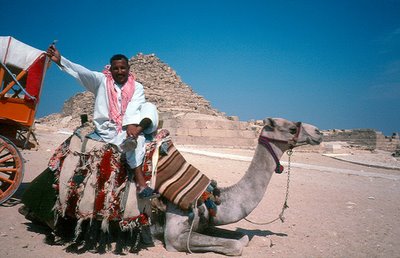 How to Regain Control of a Spooked Camel
How to Regain Control of a Spooked CamelIn some parts of North Africa and the Middle East, the camel remains the primary means of long-distance transportation. These remarkable animals are intelligent and strong, and they possess incredible endurance. They can also be quite fast: some camels can briefly attain speeds up to 40 miles per hour (64 km/h). While their speed makes them ideal for racing—camel races are very popular in many parts of the world—it can provide a camel rider with a harrowing, potentially deadly experience if a camel is spooked or otherwise begins to run out of control.
Stay calm. The camel will eventually stop. In fact, a runaway camel will usually regain its composure and slow down pretty quickly. Until it does, you need to keep your wits about you.
Hang on to the reins. Because camels are cud-chewing animals (they are constantly chewing), their reins are usually attached to a peg inserted into the nose, as opposed to being attached to a bit in the mouth, as is the case with horses. Thus, unlike with a horse, you can’t try to steer an out-of-control camel by pulling hard on the reins. A hard pull will break the reins or, worse, tear the peg out of the camel’s nose, which will cause it to panic even more. While you don’t want to pull on the reins too much, you do want to make sure to keep hold of them so you can steer the camel once it slows down.
If the reins are attached to a head halter, as is often the case with camels that are ridden on tourist expeditions, you can pull on the reins to get the camel to turn in a circle and, eventually, slow down. Work with the camel, not against it. Pull the reins to the side that the camel wants to turn its head. If the camel decides to turn its head the other way, allow it to do so, and pull the rein on that side instead.
Consider a quick dismount. If the camel is just starting to pick up speed and won’t respond to commands to stop, consider sliding off. This is especially useful if you have lost the reins. Kick out of the stirrups and attempt to hit the ground running, bending your knees slightly as you land. Note that this should not be attempted at high speeds unless there is impending danger ahead (a cliff, for example). Once you’re on the ground, try to grab the reins. The camel will most likely come to a stop once you have the reins in your hands again.
Hang on. The camel will eventually stop. Your goal is to hold on until it does. Press yourself to the camel to lower your center of gravity, grip the camel between your legs, and hold the horn of the saddle. If you aren’t using a saddle, just hold on as well as you can, and try to lean back a little so that you avoid riding near the tip of the hump, which will be a very bumpy ride at high speeds.
Get off the camel once you have it under control. Once the wild ride is over, have the camel sit. Dismount and continue to hold the reins.
Don’t get angry with the camel or strike it after you have it under control. While your adrenaline may be pumping, it’s important that you keep your cool. Camels tend to hold grudges, so if you frighten or mistreat them, they are liable to be unpleasant in the future.
Make sure you have sturdy reins and a head halter, especially if you don’t have much riding experience. A head halter can make it much easier to regain control of your camel, and you won’t have to worry about hurting it by ripping the peg out of its nose.
Learn and memorize the correct commands to give a camel while riding it. Different camels are trained to respond to different commands.
Only apply a slight pull to the reins when trying to get the camel to turn. It usually doesn’t take much, and an overzealous pull can hurt your camel if the reins are attached to a nose peg.
Most, but not all, camels like to stay close to the herd or close to home, so if you fall from your camel, the camel will likely come back once it calms down.
Hey, you never know.... stolen from Wiki-how.com



0 Comments:
Post a Comment
<< Home